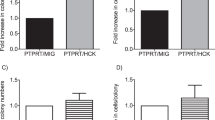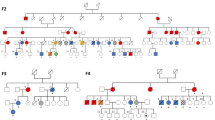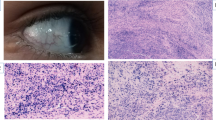Abstract
Ataxia-telangiectasia (AT) is an autosomal recessive disorder characterized by cerebellar ataxia, oculocutaneous telangiectasia, immune deficiency, genome instability and predisposition to malignancies, particularly T-cell neoplasms1–3. The responsible gene, designated ataxia-telangiectasia mutated (ATM), was recently identified by positional cloning in the chromosomal region 11q22.3–23.1 (ref. 4, 5) ATM is 150 kb in length, consists of 66 exons and encodes a nuclear phosphoprotein of approximately 350 kDa (ref. 4–9). Although ATM is considered to be a tumorigenic factor in several human cancers, it has not yet been found mutated in tumors of non-AT patients. Given the marked predisposition of AT patients to develop neoplasms of the T-cell lineage3, we analyzed a series of T-cell leukemias (T-prolymphocytic leukemia, or T-PLL) in non-AT patients in search of genomic changes associated with the development of this disease. Among the recurrent aberrations identified, deletion of the chromosome arm 11q was very frequent. Subsequent molecular cytogenetic analyses allowed us to define a small commonly deleted segment at 11q22.3–23.1 in 15 of 24 T-PLLs studied. Since this critical region contained ATM, we further analyzed the remaining copy of the gene in six cases showing deletions affecting one ATM allele. In all six cases, mutations of the second ATM allele were identified, leading to the absence, premature truncation or alteration of the ATM gene product. Thus, our study demonstrates disruption of both ATM alleles by deletion or point mutation in T-PLL, suggesting that ATM functions as a tumor-suppressor gene in tumors of non-AT individuals.
This is a preview of subscription content, access via your institution
Access options
Subscribe to this journal
Receive 12 print issues and online access
$209.00 per year
only $17.42 per issue
Buy this article
- Purchase on Springer Link
- Instant access to full article PDF
Prices may be subject to local taxes which are calculated during checkout
Similar content being viewed by others
References
Sedgewick, R.P. & Boder, E., Ataxia-talangiectasia. in Handbook of Clinical Neurology, vol. 16 (eds. Vinken, G.B.P. and Klawans, H.) 347–123 (Elsevier Scientific Publishers, New York, 1991).
Meyn, M.S. Ataxia-telangiectasia and cellular responses to DNA damage. Cancer Res. 55, 5991–6001 (1995).
Taylor, A.M.R., Metcatfe, J.A., Thick, J. & Mak, Y.F. Leukemia and lymphoma in ataxia telangiectasia. Blood 87, 423–438 (1996).
Savitsky, K. et al. A single ataxia telangiectasia gene with a product similar to Pl-3 kinase. Science 268, 1749–1753 (1995).
Savitsky, K. et al. The complete sequence of the coding region of the ATM gene reveals similarity to cell cycle regulators in different species. Hum. Mol Genet. 4, 2025–2032 (1995).
Uziel, T. et al. Genomic organization of the ATM gene. Genomics 33, 317–320 (1996).
Chen, G., Lee, E.Y.-H.P. The product of the ATM gene is a 370-kDa nuclear phospho-protein. J. Biol. Chem. 271, 33693–33697 (1996).
Lakin, N.D. et al. Analysis of the ATM protein in wild-type and ataxia telangiectasia cells. Oncogene 13, 2707–2716 (1996).
Brown, K.D. et al. The ataxia telangiectasia gene product, a constitutively expressed nuclear protein that is not up-regulated following genome damage. Proc. Natl. Acad. Sci. USA 94, 1840–1845 (1997).
Nowak, R. Discovery of AT gene sparks biomedical research bonanza. Science 268, 1700–1701 (1995).
Athma, P., Rappaport, R. & Swift, M. Molecular genotyping shows that ataxia-telangiectasia heterozygotes are predisposed to breast cancer. Cancer Genet. Cytogenet. 92, 130–134 (1996).
FitzGerald, M.G. et al. Heterozygous ATM mutations do not contribute to early onset of breast cancer. Nature Genet. 15, 307–310 (1997).
Vorechovsky, I. et al. The ATM gene and susceptibility to breast cancer: Combined mutation analysis of 38 consecutive breast tumors reveals no evidence for somatic mutations and constitutional AT heterozygosity. Cancer Res. 56, 2726–2732 (1996).
Kerangueven, F. et al. Loss of heterozygosity in human breast carcinomas in the ataxia telangiectasia, Cowden disease and BRCA1 gene regions. Oncogene 14, 339–347 (1997).
Matutes, E. et al. Clinical and laboratory features of 78 cases of T-prolymphocytic leukemia. Blood 78, 3269–3274 (1991).
Harris, N.L. et al. A revised European-American classification of lymphoid neoplasms: A proposal from the international lymphoma study group. Blood 84, 1361–1392 (1994).
Dohner, H. et al. Pentostatin in prolymphocytic leukemia: Phase II trial of the European organization for research and treatment of cancer leukemia cooperative study group. J. Natl. Cancer Inst. 85, 658–662 (1993).
Brito-Babapulle, V., Pomfret, M., Matutes, E. & Catovsky, D. Cytogenetic studies on prolymphocytic leukemia. II. T-cell prolymphocytic leukemia. Blood 70, 926–931 (1987).
Finan Daniele, R., Rowlands, D. & Nowell, P. Cytogenetics of chronic T cell leukemia, including two patients with a 14q+ translocation. Virchows Arch. Biol. Cell Pathol. 29, 121–127 (1978).
Zech, L. et al. Inversion of chromosome 14 marks human T-cell chronic lymphocytic leukemia. Nature 308, 858–860 (1984).
Croce, C.M. et al. Gene for alpha-chain of human T-cell receptor: Location on chromosome 14 region involved in T-cell neoplasms. Science 227, 1044–1047 (1985).
Virgilio, L. et al. Identification of the TCL1 gene involved in T-cell malignancies. Proc. Natl. Acad. Sci. USA 91, 12530–12534 (1994).
Narducci, M.G. et al. TCL1 oncogene activation in preleukemic T cells from a case of ataxia-telangiectasia. Blood 86, 2358–2364 (1995).
Thick, J. et al. Expression of either the TCL1 oncogene, or transcripts from its homologue MTCP1/c6.1B, in leukaemic and non-leukaemic T cells from ataxia telangiectasia patients. Oncogene 12, 379–386 (1996).
Gilad, S. etal. Predominance of null mutations in ataxia-telangiectasia. Hum. Mol. Genet. 5, 433–439 (1996).
Imai, T. et al. Identification and characterization of a new gene physically linked to the ATM gene. Genome Res. 6, 439–447 (1996).
Pittman, S., Morilla, R. & Catovsky, D., T-cell leukemias II. Cytogenetic studies. Leukocyte Res. 6, 33–42 (1982).
Hoda Maljaie, S.H. et al. Expression of c-myc oncoprotein in chronic T cell leukemias. Leukemia 9, 1694–1699 (1995).
James, M.R. et al. A radiation hybrid map of 506 STS markers spanning human chromosome 11. Nature Genet. 8, 70–76 (1994).
Zakian, V.A. ATM-related genes: What do they tell us about function of the human gene? Cell 82, 685–687 (1995).
Shafman, T. et al. Interaction between ATM protein and c-Abl in response to DNA damage. Nature 387, 520–523 (1997).
Barlow, C. et al. Atm-deficient mice: A paradigm of ataxia telangiectasia. Cell 86, 159–171 (1996).
Elson, A. et al. Pleiotropic defects in ataxia-telangiectasia protein deficient mice. Proc. Natl. Acad. Sci. USA 93, 13084–13089 (1996).
Xu, Y. et al. Targeted disruption of ATM leads to growth retardation, chromosomal fragmentation during meiosis, immune defects, and thymic lymphoma. Genes Dev. 10, 2411–2422 (1996).
Lichter, P. et al. High resolution mapping of human chromosome 11 by in situ hybridization with cosmid clones. Science 247, 64–69 (1990).
Stilgenbauer, S. et al. Molecular Cytogenetic delineation of a novel critical genomic region in chromosome bands 11 q22.3-q23.1 in lymphoproliferative disorders. Proc. Natl. Acad. Sci. USA 93, 11837–11841 (1996).
Stilgenbauer, S. et al. High frequency of monoallelic retinoblastoma gene deletion in B-cell chronic lymphoid leukemia shown by interphase cytogenetics. Blood 81, 2118–2124 (1993).
Herz, J. et al. Surface localization and high affinity for calcium of a 500-kD liver membrane protein closely related to the LDL-receptor suggest a physiological role as lipopro-tein receptor. EMBO J. 7, 4119–4127 (1988).
Van Leuven, F. et al. Structure of the gene (LRP1) coding for the human alpha 2-macro-globulin receptor lipoprotein receptor-related protein. Genomics 24, 78–89 (1994).
Beaudet, A.L. & Tsui, L.-C. A suggested nomenclature for designating mutations. Hum. Mutat. 2, 245–248 (1993).
Author information
Authors and Affiliations
Rights and permissions
About this article
Cite this article
Stilgenbauer, S., Schaffner, C., Litterst, A. et al. Biallelic mutations in the ATM gene in T-prolymphocytic leukemia. Nat Med 3, 1155–1159 (1997). https://doi.org/10.1038/nm1097-1155
Received:
Accepted:
Issue Date:
DOI: https://doi.org/10.1038/nm1097-1155
This article is cited by
-
Germline CHEK2 and ATM Variants in Myeloid and Other Hematopoietic Malignancies
Current Hematologic Malignancy Reports (2022)
-
ZNF506-dependent positive feedback loop regulates H2AX signaling after DNA damage
Nature Communications (2018)
-
SAMHD1 is recurrently mutated in T-cell prolymphocytic leukemia
Blood Cancer Journal (2018)
-
Actionable perturbations of damage responses by TCL1/ATM and epigenetic lesions form the basis of T-PLL
Nature Communications (2018)
-
Early B-cell-specific inactivation of ATM synergizes with ectopic CyclinD1 expression to promote pre-germinal center B-cell lymphomas in mice
Leukemia (2015)



